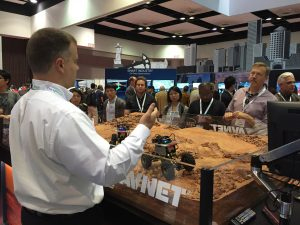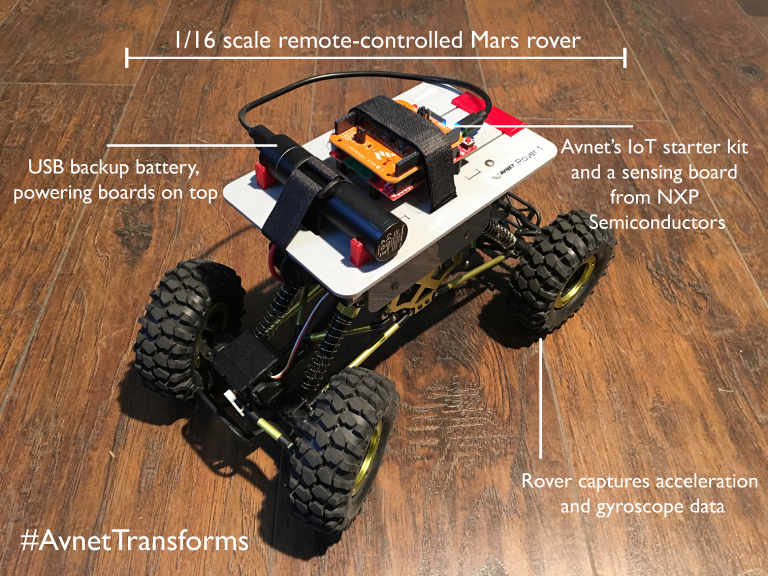 Avnet is going out of this world to show customers that they are industry leaders in the universe of IoT (Internet of Things) solutions. In November at the inaugural IoT Emerge event in Chicago, Avnet used a Mars rover mock-up to demonstrate a complete IoT-enabled application.
Avnet is going out of this world to show customers that they are industry leaders in the universe of IoT (Internet of Things) solutions. In November at the inaugural IoT Emerge event in Chicago, Avnet used a Mars rover mock-up to demonstrate a complete IoT-enabled application.
Visitors to Avnet’s fully interactive exhibit could ‘drive’ the rover around a Mars-like terrain and watch it send telemetry back from the surface of the ‘planet’ to a display screen. This allowed people to engage with various elements of the IoT solution including, integrated sensing, security and cloud connectivity.
John Weber, IoT technical solutions manager, says the idea of a Mars rover exhibit originated from the philosophy of Avnet helping customers go further. “We came up with the Mars theme because in the end, Mars is pretty far out there. And so, I thought, what sort of internet connected things would be relevant to that.”
With help from partners, Software Productivity Strategists (SPS), Weber and his team built three Mars rovers. Each Mars rover is a modified 1/16 scale remote-controlled rock crawler that’s topped by a board stack. It’s also equipped with a USB backup battery, which powers the boards on top. The boards are made up of Avnet’s IoT starter kit and a sensing board from NXP Semiconductors.
“We used our IoT starter kit, which has everything a customer needs to capture sensor data and send it to the internet,” says Weber. But his team also needed a way to digitize data and include a meaningful user interface. “We had sensors from NXP and our IoT starter kit, but we needed to bring that all together along with the third element, the cloud.” The rovers were originally built in about four weeks. Avnet had all the hardware for the rovers, and also developed the firmware. SPS built out the user interface for the rover demo.
So how did we do it?
When people visited the Avnet booth, they were able to remotely control the rover around the foam Mars terrain (a 6-foot by 8-foot piece of foam), whilst the rover was capturing the acceleration and gyroscope data. “Earth’s gravity is an acceleration vector and we capture that vector as part of it,” says Weber. “The gyroscope indicates how fast the rover is turning in three different axes.” Also, on board the rover is a digital compass, which shows what direction the rover is pointed.
The team programmed the IoT starter kit to capture sensor data at 10 times per second, changed the format into JavaScript Object Notation (JSON) and sent it to their IBM Bluemix application. The data then goes to IBM Watson IoT Foundation, the messaging service which connects to the rover and receiving messages. Users can then view the live data and real-time analytics. This is very similar to what Avnet’s customers are doing when they’re building an IoT connected product.
 The rover’s message
The rover’s message
Weber explained, “We want customers to come to us if they have a need like this because we can help them with the entire solution, through our design and support capabilities. We’re not talking about just a board they are putting together or a sensor they are building, but the entire solution.” Avnet has the ability to do this through partnerships it has with other companies — to help customers create the complete solution. The idea behind this experiment was to showcase that the rover is relevant to IoT in the sense that we’re still talking about ‘the edge’ being the rover, ‘enterprise’ being the cloud, and then making use of the data one way or the other.
Avnet already has a tremendous technology portfolio in IoT. Mindful that it needs to continually innovate, Avnet is looking at adding more value and making customers’ lives a lot easier by adding services and capabilities that push them higher in the value stack.
Avnet has the ability to provide all the ingredients, including world-class engineers that customers use to design their products. “IoT is much more than just the pieces and bits that make up a board. It’s about an entire system,” says Weber.







